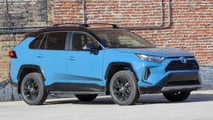
There are literally millions of Americans who wake up every day, leave their bedrooms and venture about their days behind the wheel of a Toyota RAV4. They’re everywhere: in shopping malls, at office parks, in the end-of-school day pickup line. Clearly, Toyota’s done something right; people are buying these things like crazy.
Yet, if someone were to ask me what I thought about the RAV4 outside of its durability and reliability merits, I’d probably draw a blank. There must be some method to Toyota’s madness, right? I mean, there are so many on the roads, for a reason. Given how many of them are hybrids, I’d wager that this could be the biggest gateway drug to full electrification among the masses. So when Toyota reached out to me asking if I’d like to get some seat time with the RAV4 Hybrid, I figured I should finally learn why exactly this model is so dang popular.
After an unexpected week with one of the most ubiquitous crossovers on the planet, I understand why so many people drive them, even if it’s not really my cup of tea.
2025 Toyota RAV4 Hybrid XSE
What’s a RAV4?
In 1994, Toyota literally created the whole small car-based crossover class when it took some running gear from a Corolla sedan and married to a buxom, strapping off-road-ready body with optional all-wheel drive. The resultant “Recreational Active Vehicle, 4-wheel drive” was a hit. Since its introduction, Toyota has sold more than 10 million units worldwide. Safe to say, the thing is a hit.
Yet, when it came time for the model line to go hybrid, Toyota was a little slow. The Prius may have been introduced in 1996 (2000 for markets outside of Japan,) but Toyota’s hybrid crossover efforts were limited to cars like the larger Highlander and more expensive Lexus RX300h, both introduced in 2006. A hybrid RAV4 wouldn’t show up on lots until partway through the last generation’s model, starting in 2016. That’s a full decade after Toyota’s first hybrid crossover.

For the latest generation, Toyota butched up the RAV4’s shape with some stern off-road attitude. This is a welcome change for drivers who aren’t infatuated with car-inspired designs from other manufacturers.
What’s Good About the RAV4?
The RAV4 Hybrid uses the same Toyota Hybrid System (THS) found in a plethora of other models. If you’ve driven a Sienna, Crown, Camry or Mazda CX-50 Hybrid, this car’s 2.5-liter Atkinson cycle gas engine and its trio of electric motors (including the fully electric rear axle) will sound familiar. A 1.6-kWh nickel-metal-hydride (Ni-MH) battery feeds the electric part of the RAV4 Hybrid. Fuel economy is rated for 41 city, 38 highway, and 39 combined mpg.
Unlike its Mazda cousin, the RAV4’s observed fuel economy came close to its target goal. At 70 mph freeway stints, the onboard fuel economy calculator sat at a healthy 37 mpg. I drove the car around town in somewhat chilly weather with little regard for economical cruising, and averaged a very solid 35 mpg in mixed driving. I’m sure a more diligent driver would easily beat my economy ratings, but it’s nice to get behind the wheel of a hybrid that at least attempts to save fuel.

The RAV4’s dashboard layout is straightforward. Perhaps I’ve been brainwashed by big-screen syndrome and have learned to enjoy spartan screen-only interfaces, but I can understand why the RAV4’s button-heavy approach is appealing. Nearly every function has a button, and it’s all clearly labeled. Like most Toyota products, all of the plastics fit together nicely and look good, but don’t expect an abundance of soft-touch plastics. You’ll have to step up to the Lexus NX for that one.
What’s not so good about the RAV4?
The Toyota Hybrid System’s dynamic qualities can vary wildly. For many, the car’s power delivery can feel syrupy, inconsistent and unnatural, as the car’s onboard computers do their best to make sure the car is moving down the road in its most efficient way. However, there are different tunings of the system, like in the CX-50 hybrid or the new Prius that feel more natural, if not sporty. Better pedal calibration and a more consistent and predictable balance of gas engine and electric power assist should help the car avoid some of the weird throttle feel or eCVT drone common on a Toyota hybrid.
This is not one of those cars, though.
The RAV4 Hybrid is the poster child for syrupy and disconnected power delivery. I’d bet that most normal drivers won’t notice or care all that much, but if you dip into that engine for more power, it really feels out of its element. Hard acceleration is accompanied by rubber banding as the engine screams and then the car makes pace with the road, exacerbated by the RAV4’s coarse engine note and comparatively loud cabin.

Its on-road dynamics are also just okay. The suspension tuning is inherently soft, enough to make it unfazed by one-off freeway expansion joints. More moderate bumps reward the passengers with a somewhat busy and slightly floaty ride more in common with a truck-based SUV than in a car-based crossover. The steering ratio is somewhat fast, but the car is fairly clumsy and doesn’t carry its weight particularly well if you push things outside normal RAV4 duties like, say, keeping up with traffic. I’m not saying it needs to be a track-ready race car, but competitors like the CR-V hybrid or CX-50 hybrid are more graceful and better resolved by comparison.
Also, the RAV4’s interior space is solidly mid-pack. I hesitate to call it tight, but at 37.8 inches of rear legroom, this crossover trails its competitors. The Honda CR-V hybrid has a whopping 41 inches of rear legroom. That’s way better for passengers or small families with car seats, who I would imagine buy RAV4s in droves.
Verdict
In all, the RAV4 Hybrid is a pleasant car, even if it’s not groundbreaking in any real way. Personally, I don’t think I’ll ever have a reason to buy this type of vehicle—it is far too dynamically out of step with what I’d expect from a small crossover to be my daily driver.

But, this ain’t about me. A lot of the negatives can easily be spun into positive aspects for the people who buy these things. The lack of soft-touch plastics could be considered easier to clean and maintain, especially for families with small children, or people using these for rideshare duties. I don’t like the ride and handling of this car, but I recognize that what I may have described as “clumsy” could easily be considered by some as having a “true SUV feel,” without the downsides of poor fuel economy. Toyota is certainly doing something right, since as recently as 2022 nearly of all RAV4s are hybrids.
If anything, it bodes well for Toyota’s future full electrification efforts. In principle, the bZ4X is effectively a fully electric version of the RAV4. Despite the bZ4X’s poor range and lackluster specs, it has been a moderate success for Toyota for similar reasons that people like the RAV4. It’s an inoffensive entry into a market where specifications aren’t always the top concern among buyers. The bZ4X and RAV4 are two sides of the same coin; they’re workhorses sold to people who have a strong perception of Toyota’s reliability and dependability, and want the peace of mind that comes with that.
The car just has to be not horrible. I get why people buy them.
Contact the author: Kevin.Williams@InsideEVs.com
Gallery: 2025 Toyota RAV4 Hybrid Review














